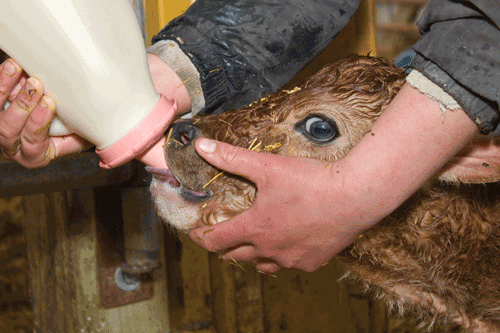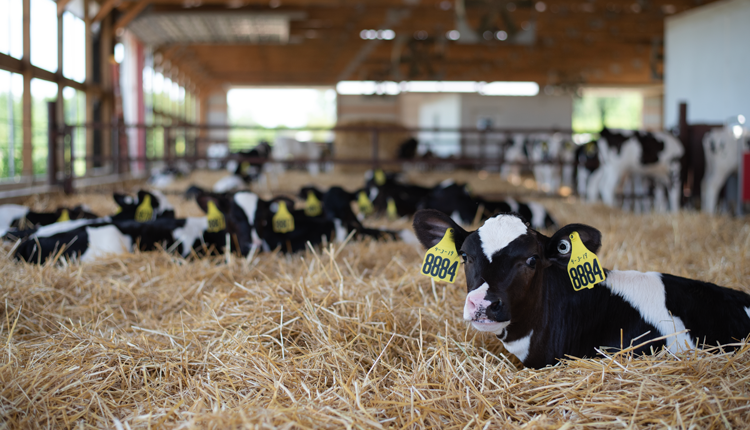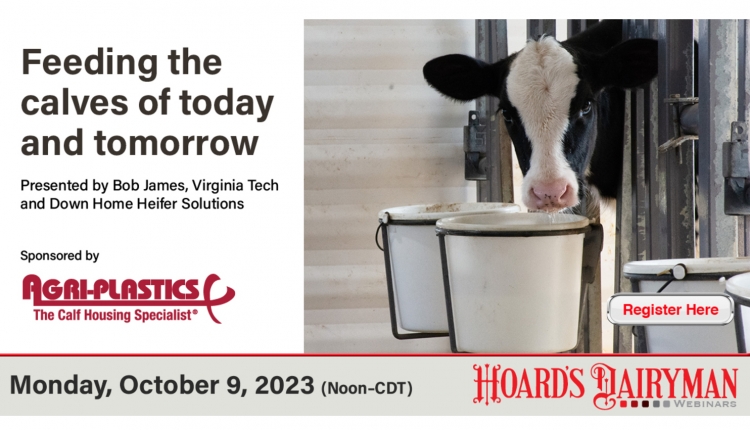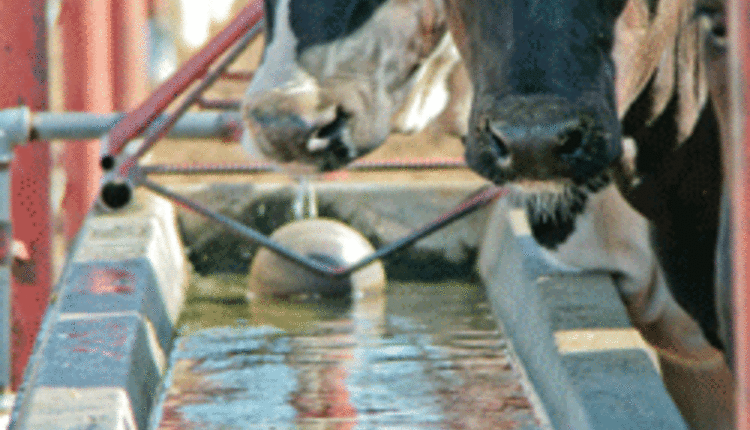The author is in the California Animal Health and Food Safety Laboratory, University of California, Tulare.

That first feeding of colostrum plays a big role
in preventing septicemias in dairy calves .
Next to diarrheas, bacterial septicemias and bacterial and viral pneumonias are major diseases that affect large numbers of animals and kill many calves. These problems can occur at any time in early life and must be identified quickly. Often, calves with septicemias and pneumonias are difficult to tell apart because those affected show up as acute deaths or having respiratory distress.
Bacterial septicemias caused by E. coli often occur in calves between 3 and 21 days of age. E. coli septicemia may or may not be associated with E. coli infections of the intestines or navel. Salmonella septicemias caused by Salmonella Newport and Salmonella Typhimurium primarily occur between 7 and 21 days.
Salmonella Dublin septicemias are most common in calves between 30 and 90 days of age. Clinically, they often are found dead or have high fevers (104°F) and a cough. You also may see swollen joints and cloudy eyes in some calves. All of these infections may or may not be associated with diarrhea.
What you'll see
Necropsy examination of infected animals often identifies fibrin over the surface of the intestines and/or lungs, swollen lymph nodes, and swollen joints. In Salmonella Dublin infections, you commonly will see an enlarged spleen, swollen and edematous lymph nodes, swollen yellow liver, and wet, heavy, edematous, and hemorrhagic lungs. In the winter, Salmonella septicemias (particularly Salmonella Dublin) may cause necrosis and loss of the animal's ears, tail, and rear feet. You must provide prompt antibiotic therapy and supportive care to save the septicemic calf.
It is critical that you identify the bacterial agent responsible for the septicemia in order to prevent further deaths. Only by culturing selected organs (usually the lungs and liver) in the sick calves for the bacteria responsible for the septicemia are you able to identify the causative agent. Once you know the agent responsible for the septicemia, you are able to identify the antibiotics that can inhibit bacterial growth and are best to use for these sick calves.
Preventing these bacterial septicemias (particularly E. coli) often requires a close look at your colostrum management. Inadequate colostrum intake or use of poor-quality colostrum often leads these calves to septicemias. Those that get inadequate or no colostrum also can absorb E. coli allowing these organism to quickly transport across the small intestines into the lymphatics and bloodstream. This then can lead to an E. coli septicemia.
Poor nutrition resulting in stressed, immunocompromised calves also can play an important role. Examine your ration quality and quantity, particularly for calves between 10 and 30 days of age when they are rapidly growing and still have an immature immune system. Making sure that calves get adequate energy, as well as proper protein, vitamin, and mineral levels, is important. Keeping the navel clean, dry, and dipped in an appropriate disinfectant also is critical.
In Salmonella outbreaks, you also must take a close look at current procedures. In young calves that are getting milk, evaluate pasteurization procedures and how you're storing pasteurized milk. Often, these outbreaks occur when feeding unpasteurized hospital or bulk tank milk or the pasteurizer has malfunctioned.
Check other feed sources to see if they are being contaminated by flies and rodents. Make sure that those who feed and treat infected calves are following proper biosecurity plans to prevent infecting other animals.
Rarely does pneumonia occur in calves less than 30 days of age. Most respiratory infections show up between 30 and 120 days of age. Bovine respiratory syncytial virus (BRSV), parainfluenza-3 (PI-3) virus, and infectious bovine rhinotracheitis (IBR) virus are the major viral pathogens seen in calves. These viruses may cause mild to severe respiratory disease. BRSV and to a lesser extent, PI-3, tend to be responsible for a severe viral bronchopneumonia. IBR tends to be associated more with upper respiratory diseases involving the nose (nasal discharge), eyes (tearing, conjunctivitis, and occasionally corneal edema) and trachea (coughing) but also can be associated with bronchopneumonia, too.
These viral pathogens often make calves more susceptible to bacterial pathogens. The most common acute bacterial pathogens commonly associated with or without these viral infections are Pasteurella multocida, Bibersteinia trehalosi, Mannheimia haemolytica, and Histophilus somni.
In order to prevent significant outbreaks of respiratory disease, you must make proper identification of the pathogen. Often, when these outbreaks occur, there was some problem with vaccination protocols on a group of calves.
It is critical to follow the manufacturer's vaccination recommendations and store the vaccine under the appropriate conditions (refrigerated until just before use and kept out of the heat and sun). Also, remember that you need to feed a balanced ration to the growing calf to ensure its immune system is functioning properly.
If you administer antibiotics to sick animals, it is important that you follow treatment protocols correctly to ensure that adequate levels of antibiotics are maintained in the animal to properly kill the bacterial agent responsible for the respiratory disease. Stopping treatments early because the calf is improving often results in antibiotic resistance.
Mycoplasma infections (particularly Mycoplasma bovis) tend to be associated with chronic pneumonias and often are not directly associated with viral infections. You'll see most Mycoplasma infections in calves 20 to 40 days of age. Those with Mycoplasma bovis respiratory infections often have joint infections and head tilt due to a middle ear infection.
While we see Mycoplasma bovis in many cases of middle ear infections, our laboratory also has identified many of the common respiratory pathogens (Pasteurella multocida, Mannheimia haemolytica, Bibersteinia trehalosi and Histophilus somni) in the middle ear. This suggests that these organisms often cause the initial middle ear infection and predispose the ear to Mycoplasma infections.
Watch sanitation
It is thought that drinking unpasteurized or poorly pasteurized hospital milk can be a predisposing factor in Mycoplasma infections. It also is possible that infections are being spread from calf to calf by contaminated, poorly cleaned milk bottles and nipples. As with other bacterial pathogens, the diagnosis of Mycoplasma infections requires the presentation of sick or dead calves for necropsy and bacterial culturing of the infected lungs, joints, and/or middle ears to determine which bacteria is the cause of the pneumonia, joint, or middle ear infection.
Another bacteria commonly found in pneumonia calves is Arcanobacterium pyogenes. This bacterium is felt to be a secondary opportunistic pathogen. These bacteria probably only arrive in the pneumonic lung after the primary bacteria (Pasteurella, Bibersteinia, Mannheimia, or Histophilus) have damaged the lung tissues.
Submitting diagnostic samples from sick or dead calves to your herd veterinarian or to your regional animal diagnostic laboratory for disease identification can help you identify and correct disease problems and underlying management issues. Once you know the bacterial, viral, or protozoal agent responsible, you can address management issues involving sanitation, biosecurity, nutrition, and calf care.
Click here to return to the Calf & Heifer E-Sources
111010_631

in preventing septicemias in dairy calves
Next to diarrheas, bacterial septicemias and bacterial and viral pneumonias are major diseases that affect large numbers of animals and kill many calves. These problems can occur at any time in early life and must be identified quickly. Often, calves with septicemias and pneumonias are difficult to tell apart because those affected show up as acute deaths or having respiratory distress.
Bacterial septicemias caused by E. coli often occur in calves between 3 and 21 days of age. E. coli septicemia may or may not be associated with E. coli infections of the intestines or navel. Salmonella septicemias caused by Salmonella Newport and Salmonella Typhimurium primarily occur between 7 and 21 days.
Salmonella Dublin septicemias are most common in calves between 30 and 90 days of age. Clinically, they often are found dead or have high fevers (104°F) and a cough. You also may see swollen joints and cloudy eyes in some calves. All of these infections may or may not be associated with diarrhea.
What you'll see
Necropsy examination of infected animals often identifies fibrin over the surface of the intestines and/or lungs, swollen lymph nodes, and swollen joints. In Salmonella Dublin infections, you commonly will see an enlarged spleen, swollen and edematous lymph nodes, swollen yellow liver, and wet, heavy, edematous, and hemorrhagic lungs. In the winter, Salmonella septicemias (particularly Salmonella Dublin) may cause necrosis and loss of the animal's ears, tail, and rear feet. You must provide prompt antibiotic therapy and supportive care to save the septicemic calf.
It is critical that you identify the bacterial agent responsible for the septicemia in order to prevent further deaths. Only by culturing selected organs (usually the lungs and liver) in the sick calves for the bacteria responsible for the septicemia are you able to identify the causative agent. Once you know the agent responsible for the septicemia, you are able to identify the antibiotics that can inhibit bacterial growth and are best to use for these sick calves.
Preventing these bacterial septicemias (particularly E. coli) often requires a close look at your colostrum management. Inadequate colostrum intake or use of poor-quality colostrum often leads these calves to septicemias. Those that get inadequate or no colostrum also can absorb E. coli allowing these organism to quickly transport across the small intestines into the lymphatics and bloodstream. This then can lead to an E. coli septicemia.
Poor nutrition resulting in stressed, immunocompromised calves also can play an important role. Examine your ration quality and quantity, particularly for calves between 10 and 30 days of age when they are rapidly growing and still have an immature immune system. Making sure that calves get adequate energy, as well as proper protein, vitamin, and mineral levels, is important. Keeping the navel clean, dry, and dipped in an appropriate disinfectant also is critical.
In Salmonella outbreaks, you also must take a close look at current procedures. In young calves that are getting milk, evaluate pasteurization procedures and how you're storing pasteurized milk. Often, these outbreaks occur when feeding unpasteurized hospital or bulk tank milk or the pasteurizer has malfunctioned.
Check other feed sources to see if they are being contaminated by flies and rodents. Make sure that those who feed and treat infected calves are following proper biosecurity plans to prevent infecting other animals.
Rarely does pneumonia occur in calves less than 30 days of age. Most respiratory infections show up between 30 and 120 days of age. Bovine respiratory syncytial virus (BRSV), parainfluenza-3 (PI-3) virus, and infectious bovine rhinotracheitis (IBR) virus are the major viral pathogens seen in calves. These viruses may cause mild to severe respiratory disease. BRSV and to a lesser extent, PI-3, tend to be responsible for a severe viral bronchopneumonia. IBR tends to be associated more with upper respiratory diseases involving the nose (nasal discharge), eyes (tearing, conjunctivitis, and occasionally corneal edema) and trachea (coughing) but also can be associated with bronchopneumonia, too.
These viral pathogens often make calves more susceptible to bacterial pathogens. The most common acute bacterial pathogens commonly associated with or without these viral infections are Pasteurella multocida, Bibersteinia trehalosi, Mannheimia haemolytica, and Histophilus somni.
In order to prevent significant outbreaks of respiratory disease, you must make proper identification of the pathogen. Often, when these outbreaks occur, there was some problem with vaccination protocols on a group of calves.
It is critical to follow the manufacturer's vaccination recommendations and store the vaccine under the appropriate conditions (refrigerated until just before use and kept out of the heat and sun). Also, remember that you need to feed a balanced ration to the growing calf to ensure its immune system is functioning properly.
If you administer antibiotics to sick animals, it is important that you follow treatment protocols correctly to ensure that adequate levels of antibiotics are maintained in the animal to properly kill the bacterial agent responsible for the respiratory disease. Stopping treatments early because the calf is improving often results in antibiotic resistance.
Mycoplasma infections (particularly Mycoplasma bovis) tend to be associated with chronic pneumonias and often are not directly associated with viral infections. You'll see most Mycoplasma infections in calves 20 to 40 days of age. Those with Mycoplasma bovis respiratory infections often have joint infections and head tilt due to a middle ear infection.
While we see Mycoplasma bovis in many cases of middle ear infections, our laboratory also has identified many of the common respiratory pathogens (Pasteurella multocida, Mannheimia haemolytica, Bibersteinia trehalosi and Histophilus somni) in the middle ear. This suggests that these organisms often cause the initial middle ear infection and predispose the ear to Mycoplasma infections.
Watch sanitation
It is thought that drinking unpasteurized or poorly pasteurized hospital milk can be a predisposing factor in Mycoplasma infections. It also is possible that infections are being spread from calf to calf by contaminated, poorly cleaned milk bottles and nipples. As with other bacterial pathogens, the diagnosis of Mycoplasma infections requires the presentation of sick or dead calves for necropsy and bacterial culturing of the infected lungs, joints, and/or middle ears to determine which bacteria is the cause of the pneumonia, joint, or middle ear infection.
Another bacteria commonly found in pneumonia calves is Arcanobacterium pyogenes. This bacterium is felt to be a secondary opportunistic pathogen. These bacteria probably only arrive in the pneumonic lung after the primary bacteria (Pasteurella, Bibersteinia, Mannheimia, or Histophilus) have damaged the lung tissues.
Submitting diagnostic samples from sick or dead calves to your herd veterinarian or to your regional animal diagnostic laboratory for disease identification can help you identify and correct disease problems and underlying management issues. Once you know the bacterial, viral, or protozoal agent responsible, you can address management issues involving sanitation, biosecurity, nutrition, and calf care.
111010_631









